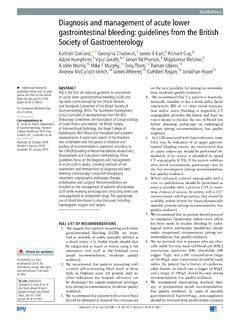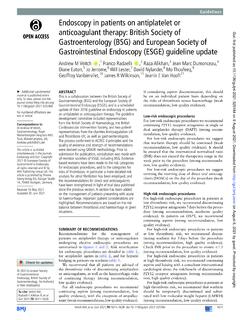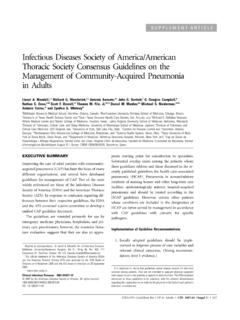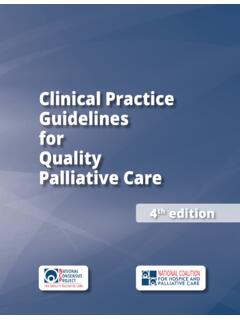Transcription of Guidelines British Society of Gastroenterology consensus ...
1 1 Lamb CA, et al. Gut 2019;0:1 106. Introduction 62 Methodology 63 Ulcerative colitis Diagnosis Histology UC versus Crohn s disease Phenotypic classification Clinical and endoscopic disease activity Treatment targets Initial treatment of active UC with 5-ASA 5-ASA dose Oral and enema 5-ASA Nephrotoxicity 11 GuidelinesBritish Society of Gastroenterology consensus Guidelines on the management of inflammatory bowel disease in adultsChristopher Andrew Lamb, 1,2 Nicholas A Kennedy, 3,4 Tim Raine, 5 Philip Anthony Hendy, 6,7 Philip J Smith, 8 Jimmy K Limdi, 9.
2 10 Bu Hussain Hayee, 11,12 Miranda C E Lomer, 12,13 Gareth C Parkes, 14,15 Christian Selinger, 16,17 Kevin J Barrett, 18 R Justin Davies, 5,19 Cathy Bennett, 20,21 Stuart Gittens, 22 Malcolm G Dunlop, 23,24 Omar Faiz, 7,25 Aileen Fraser, 26 Vikki Garrick, 27 Paul D Johnston, 28 Miles Parkes, 5 Jeremy Sanderson, 12,13 Helen Terry, 28 IBD Guidelines eDelphi consensus group, Daniel R Gaya, 29,30 Tariq H Iqbal, 31,32 Stuart A Taylor, 33,34 Melissa Smith, 35,36 Matthew Brookes, 37,38 Richard Hansen, 27,30 A Barney Hawthorne 39to cite: Lamb CA, Kennedy NA, Raine T, et al. Gut Epub ahead of print: [please include Day Month Year].
3 Additional material is published online only. To view please visit the journal online (http:// dx. doi. org/ 10. 1136/ gutjnl- 2019- 318484).For numbered affiliations see end of toDr Christopher Andrew Lamb, Institute of Cellular Medicine, Newcastle University, Framlington Place, Newcastle upon Tyne NE2 4HH, UK; christopher. lamb@ newcastle. ac. uk and Dr A Barney Hawthorne, Department of Gastroenterology , University Hospital of Wales, Cardiff, CF14 4XW; barney. hawthorne@ wales. nhs. ukReceived 10 February 2019 Revised 10 June 2019 Accepted 10 June 2019 Author(s) (or their employer(s)) 2019.
4 Re-use permitted under CC BY-NC. No commercial re-use. See rights and permissions. Published by colitis and Crohn s disease are the principal forms of inflammatory bowel disease. Both represent chronic inflammation of the gastrointestinal tract, which displays heterogeneity in inflammatory and symptomatic burden between patients and within individuals over time. Optimal management relies on understanding and tailoring evidence-based interventions by clinicians in partnership with patients. This guideline for management of inflammatory bowel disease in adults over 16 years of age was developed by Stakeholders representing UK physicians ( British Society of Gastroenterology ), surgeons (Association of Coloproctology of Great Britain and Ireland), specialist nurses (Royal College of Nursing), paediatricians ( British Society of Paediatric Gastroenterology , Hepatology and Nutrition), dietitians ( British Dietetic Association), radiologists ( British Society of Gastrointestinal and Abdominal Radiology), general practitioners (Primary Care Society for Gastroenterology )
5 And patients (Crohn s and Colitis UK). A systematic review of 88 247 publications and a Delphi consensus process involving 81 multidisciplinary clinicians and patients was undertaken to develop 168 evidence- and expert opinion-based recommendations for pharmacological, non-pharmacological and surgical interventions, as well as optimal service delivery in the management of both ulcerative colitis and Crohn s disease. Comprehensive up-to-date guidance is provided regarding indications for, initiation and monitoring of immunosuppressive therapies, nutrition interventions, pre-, peri- and postoperative management , as well as structure and function of the multidisciplinary team and integration between primary and secondary care.
6 Twenty research priorities to inform future clinical management are presented, alongside objective measurement of priority importance, determined by 2379 electronic survey responses from individuals living with ulcerative colitis and Crohn s disease, including patients, their families and CA, et al. Gut 2019;0:1 106. Corticosteroids in mild to moderate UC Budesonide MMX Beclomethasone dipropionate Corticosteroids in moderate to severe UC Failure of oral corticosteroids 5-ASA maintenance therapy for UC Treatment options for UC patients after 5-ASA failure Thiopurines Infliximab Adalimumab Golimumab Vedolizumab Tofacitinib Ustekinumab Methotrexate Choice of immunosuppressive or biological therapy Therapeutic choice after anti-TNF failure Vedolizumab after anti-TNF therapy Tofacitinib after anti-TNF therapy
7 Proctitis 5-ASA suppositories in proctitis Maintenance therapy for proctitis Corticosteroid suppositories in proctitis Treatment options in refractory proctitis Stopping 5-ASA or thiopurine therapy Acute severe ulcerative colitis Corticosteroid therapy for ASUC Predictors of outcomes of ASUC Ciclosporin or infliximab rescue therapy for ASUC Ciclosporin in ASUC Infliximab in ASUC Comparison of infliximab and ciclosporin in ASUC Sequential therapy (infliximab and ciclosporin) in refractory ASUC Accelerated infliximab induction regimen in ASUC Colectomy for ASUC Surgical management in UC Emergency colectomy for UC Outcomes after colectomy for UC Surgery in UC patients with primary sclerosing cholangitis Fertility and delivery after restorative proctocolectomy Pouches and pouchitis Assessment of new symptoms after IPAA Treatment of acute pouchitis Treatment of chronic pouchitis Treatment with biologics in chronic refractory pouchitis Follow-up of pouch patients Pouch surveillance 264 Crohn s disease Diagnosis.
8 Classification and assessment Phenotypic classification Clinical and endoscopic disease activity 273 Lamb CA, et al. Gut 2019;0:1 106. Diagnostic tests Cross-sectional imaging: CT, MR and small bowel ultrasound Detection of active disease Investigation of strictures Radiation exposure Capsule endoscopy Balloon-assisted enteroscopy Induction of remission in mild to moderate disease ileocolonic disease Budesonide in ileocaecal Crohn s disease Corticosteroids in colonic Crohn s disease Nutritional therapy Exclusive Enteral Nutrition (EEN) Elimination diets Antibiotic therapy Surgery in localised ileocaecal Crohn s disease Initial treatment of moderate to severe ileocolonic Crohn s disease Corticosteroids Early use of biological therapy Maintenance treatment in ileocolonic Crohn s disease Immunomodulator therapy Thiopurine therapy Methotrexate Mesalazine Biological therapy with anti-TNF drugs.
9 Vedolizumab or ustekinumab Infliximab Adalimumab Choice of anti-TNF agent in Crohn s disease Vedolizumab Ustekinumab Choice of biological therapy after anti-TNF failure Corticosteroid use and infection risk while on anti-TNF therapy Haematopoietic stem cell transplantation Leucocyte apheresis Proximal jejunal or extensive small bowel disease Upper gastrointestinal Crohn s disease Orofacial granulomatosis Stricturing disease Medical therapy for strictures Surgical therapy for strictures Strictureplasty Endoscopic therapy for strictures Non-perianal fistulising Crohn s disease and abscesses Intra-abdominal abscesses Medical therapy Enterovaginal and enterovesical fistulae Enteroenteric fistulae Enterocutaneous fistulae Anti-TNF therapy for non-perianal fistulae Perianal Crohn s disease Assessment of perianal disease Seton insertion Anti-TNF therapy post-surgery for complex perianal fistulae 404 Lamb CA, et al.
10 Gut 2019;0:1 106. Infliximab for perianal fistulising disease Adalimumab for perianal fistulising disease Combined surgical treatment with anti-TNF therapy Vedolizumab and ustekinumab therapy Surgical treatment of fistulae Allogeneic adipose-derived stem cell therapy for perianal fistulae Defunctioning stoma formation Post-surgical management of Crohn s disease Disease recurrence following ileocolonic resection Investigation for symptomatic recurrence following ileocolonic resection Non-inflammatory causes of diarrhoea after ileocolonic resection Smoking cessation following















